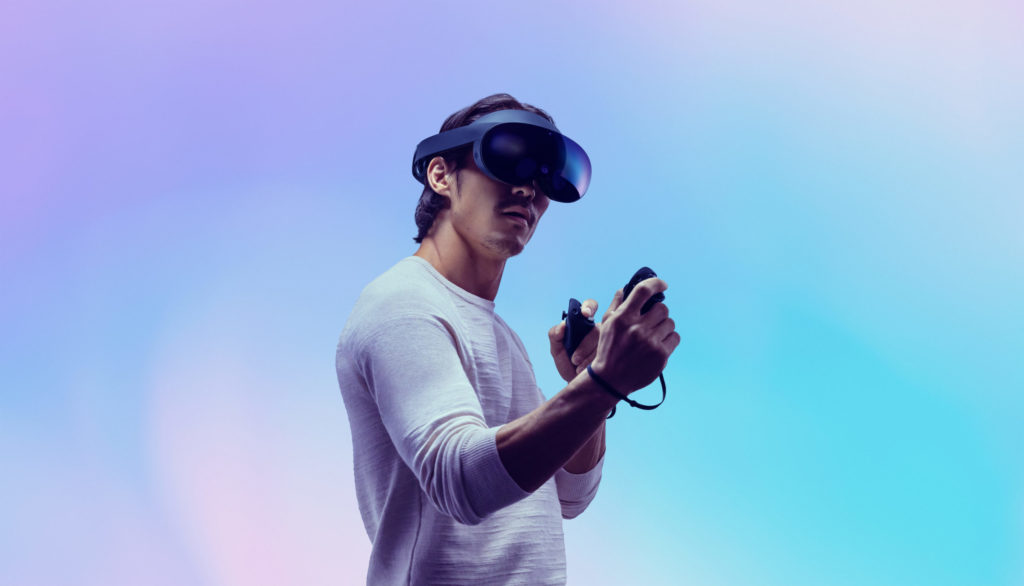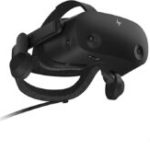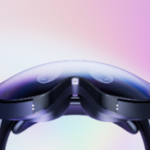Everything you need to know about Meta’s new all-in-one VR headset.
After long last, Meta has officially unveiled the Meta Quest Pro (formerly Project Cambria), a high-powered VR headset with full-color mixed reality capabilities. The first in a new line of high-end devices, the highly-anticipated standalone headset was revealed this morning at Meta Connect 2022, during which the company shared a plethora of information regarding specs, pricing, accessories, and more.
Here’s everything you need to know about the Quest Pro, Meta’s latest VR headset:
The Specs
The Quest Pro is a “high-end” device capable of VR as well as mixed reality. The headset is powered by the all-new Qualcomm Snapdragon XR2+ platform, making it 50% more powerful than the Meta Quest 2 while providing better thermal dissipation. Each headset features 12GB of RAM and 256GB of storage.
Meta chose to use pancake optics as opposed to the Fresnel lenses featured on the Quest 2, allowing them to reduce the optical module by a whopping 40% while delivering 37% more pixels per inch and 10% greater pixels per degree than the Quest 2. The device features a 106º horizontal and 96º vertical field-of-view and a max refresh rate of 90Hz.
Two LCD displays boasting quantum dot technology offer crisp, colorful visuals made even better by the company’s local dimming technology, which controls 500 LED blocks to deliver 75% more contrast. The result is sharp, clean visuals. In terms of audio, the Quest Pro features 360-degree spatial audio, a built-in mic, and twin left/right 3.5mm headphone jacks. A full charge gets you roughly two hours of use.
The Design
Unlike the Quest 2, the Quest Pro is less of a gaming device and more of a multipurpose design and collaboration tool. The headset is designed to enhance your productivity using virtual content while keeping you grounded in reality. As such, the device features a unique open peripheral design that allows you to interact with virtual content while remaining aware of your physical surroundings. That said you can use partial light blockers to immerse yourself in select experiences, but more on that later.
As previously mentioned, the use of pancake optics has allowed Meta to reduce the optical module by 40%. The Quest Pro features a curved-cell battery located at the back of the device, resulting in better weight distribution. A crank wheel located at the back of the headset allows you to easily adjust the tightness of the device, a noticeable improvement from the Quest 2’s fabric straps.
A continuous lens spacing adjustment mechanism allows you to adjust the space between the lenses to your preferred inter-pupillary distance (IPD) between 55mm and 75mm, a larger range than that provided by the Quest 2. What’s really cool is the auto-adjustment software which notifies you if you’re wearing the device incorrectly. In terms of weight, the Quest Pro comes in at roughly 1.59 pounds, slightly more than the Quest 2.
The Mixed Reality
In addition to VR, the Quest Pro is capable of delivering 3D mixed reality experiences thanks to full-color stereoscopic Passthrough technology. High-resolution outward-facing cameras triangulate your position and map your environment in real-time, allowing you to “see” the physical world in stunning detail. The Quest Pro’s cameras feature 4x the pixels of the Quest 2’s cameras, and the results are noticeable. The visuals are so clear you can actually read some text in-headset.
Using the company’s Presence Platform, developers can create engaging mixed reality experiences that blend virtual content with the real world. This could be anything from a virtual workspace featuring multiple monitors to a next-gen art studio that allows you to hang virtual paintings throughout your real-world space.
Scene understanding and Shared Spatial Anchors allow users to collaborate with one another in a shared space simultaneously. You can even drop virtual objects in a specific location in the real world and return to them later.
The Controllers
The Quest Pro features a new set of self-tracking controllers. Whereas the Quest 2 Touch controllers require the assistance of the headset’s sensors in order to function, each Touch Pro controller features three built-in sensors which track their positions in a 3D space.
The Touch Pro controllers also feature a new ergonomic design as well as upgraded haptics powered by the TruTouch Haptics system. A rechargeable battery system removes the need for old-school disposable batteries. Each headset comes with a charging dock and 45W USB-C power adapter, but more on accessories later.
As if that weren’t cool enough, the Touch Pro controllers are can be purchased separately and are compatible with the Meta Quest 2. So even if you have no intention of picking up the Quest Pro, you can still take advantage of the new controllers to improve your current setup. The Touch Pro controllers will be available for purchase later this year for $299.
The Eye & Face Tracking
As previously announced, the Quest Pro features eye tracking and Natural Facial Expressions, which has allowed the company to do some pretty cool things with avatars. After calibrating your face in the settings, the headset tracks the movement of your pupils as well as any subtle facial expressions to deliver more authentic interactions.
This technology can also be used in a variety of other ways, from menu navigation to system optimization through a technique called foveated rendering. In a recent demo, I sampled a unique program that allowed me to control the face of a strange alien avatar. Despite being a simple tech demo, I found myself absolutely captivated by the experience.
Both eye and face tracking will be off by default; you’ll need to activate these manually in your settings. According to Meta, images of your eyes and face are deleted after processing and are never shared with the company or any outside organizations.
The Games & Apps
The Quest Pro supports both VR and mixed reality content, offering a little something for everyone. During a hands-on demo with the headset, I was able to try a small selection of new and existing games made even better by the Quest Pro’s mixed reality capabilities.
One of my favorites was Tribe XR, a VR DJ app available now on Quest and PC VR headsets. During my brief demo, I connected virtually with a professional instructor who guided me through the finer points of beatmatching. I also enjoyed Wooorld, a GeoGuessr-type game that allowed me to explore famous cities around the world in mixed reality.
Then there was Painting VR, a VR art program that allowed me to create my own virtual art and hang it throughout my real-world space. And thanks to the aforementioned Spatial Anchors, my art remained permanently fixed in my real-world space, even after closing the app, allowing other guests to contribute to the virtual gallery throughout the day. We’ll talk more about content soon.
According to Meta, the Quest Pro is compatible with all Quest 2 games and apps. You can even use Link an Air Link to access PC VR content.
The Accessories
The Quest Pro will feature no shortage of killer accessories right out of the gate. Each headset comes with a variety of useful add-ons designed to enhance your experience. This includes partial light blockers, a dedicated charging dock, and a 5W USB-C power adapter. There’s also a new stylus accessory that can be mounted to the bottom of the Touch Pro controller for more realistic drawing and writing in VR. This is especially useful when working in Horizon Workrooms, Meta’s own VR coworking platform.
In addition to the accessories that come with the Quest Pro, the company will offer several premium accessories at an additional price.
- Meta Quest Pro Compact Charging Dock ($79.99, October 25)
- Meta Quest Pro Full Light Blocker ($49.99, November 22)
- Meta Quest Pro VR Earphones ($49.99, October 25)
- Meta Quest Pro Carry Case from Incase ($119.95, October 25)
The Price & Release Date
The Meta Quest Pro will be available for purchase on October 25th for $1,499.99 via the Meta Store in 22 countries as well as Best Buy and Amazon in the US. Each purchase includes the Quest Pro headset, two Touch Pro controllers, stylus tips, partial light blockers, and a charging dock.
You can try the device out for yourself at the Meta Store in Burlingame, California beginning October 14th, or at Adobe Max in Los Angeles October 18th – 20th. We’ll have a more detailed hands-on report ready for you soon!
For more information visit here.
Image Credit: Meta
The post Meta Quest Pro Revealed: Specs, Price, Release Date appeared first on VRScout.











